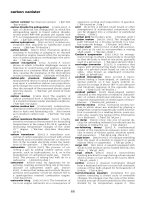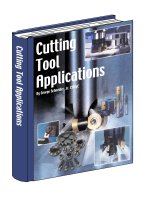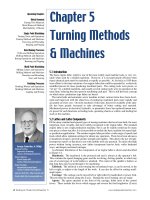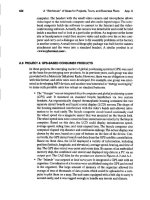21st Century Manufacturing Episode 1 Part 5 ppsx
Bạn đang xem bản rút gọn của tài liệu. Xem và tải ngay bản đầy đủ của tài liệu tại đây (610.35 KB, 20 trang )
74 Manufacturing Analysis: Some Basic Questions for a start-up Company Chap. 2
with standard cable connection to a computer. The top surface of the enclosure has to
be smooth and ergonomic for the finger to sit comfortably on the sensing array.
2.10.3 Det_it Design
At the "detail design" stage, a CAD representation (in
SDRC-IDEAS)
was created
to check the fit of the electronics and the basic form factor. The top lid was designed
to package the PCBs, single- and double-board versions, and to provide a comfort-
able support for the user's finger. The base provided additional space for connection
ribbon cables and a power cable. Both the top lid and the base were designed to be
fastened together.
2.10.4 Prototyping
The next step was to decide among the different rapid prototyping methods. It was
important to fabricate a prototype that was strong enough to be structurally safe
when assembled and handled during the evaluation period. At the same time, rela-
tively high tolerances were needed to allow the PCBs to be securely fastened to the
top lid. The strength, tolerance, and surface finish achieved by the SLA process
seemed to meet these needs and was thus chosen for prototyping.
An informal group of "human users" was asked to evaluate the ergonomic
aspects of the upper surface. The user group recommended that a flat slope be
replaced with a more contoured slope that would mirror the inside surface of the
index finger.
To create this more comfortable contour for finger positioning, an important
decision was made. It was decided to switch to a Web-based, freeform design tool
(Wang and Wright, 1998a, 1998b) to create the freeform shape on the top surface.
The key issue was again time-to-market.
First, it was important to have a design tool that would produce the freeform
surface. Second, and equally important, the Web-based, freeform design tool incor-
porated a design rule checker for "downstream mold machining" (Urabe and Wright,
1997).This software assisted the designer to create both the part and a feasible mold.
By anticipating the milling process early in the design process, possible errors were
eliminated, therefore accelerating the overall design-to-manufacturing time (Table
2.7 and Figure 2.22).The Web-based freeform design was rendered with the ACIS 3D
tool kit (ACIS, 1996). A second prototype was then fabricated to evaluate the
ergonomic freeform surface (Figure 2.23).
2.10.5 Aluminum Tooling Design
After the second prototype was evaluated and modified as shown in Figure 2.24, the
shape was fixed and ready for the aluminum tooling stage for the injection molding
process. Again, the Web-based, freeform design tool, plus the ACIS solid modeling
tool kit, was selected for the complete mold design. The mold halves for the top part
of the casing are show in Figure 2.25.
While designing these mold halves, some specific molding characteristics were
considered as well. For instance, an enlargement factor of 1.014 was applied to the
2.10 Case Study
15
TABLE
2.7 Manufacturing Analysis for the Development of the TouchChip Fingerprint Device
Criteria and comments
Questions
Answer
Who is the customer?
Conceptual design?
What is the cost?
(a) batch size?
What is the cost?
(b) accuracy and
tolerances?
How much quality?
Delivery time?
flexibility?
Original
equipment
manufacturer (OEM) of
biometric security
devices for computer
applications
1.Small and ergonomic
2. Simple computer
interfacing
200-300 assemblies
Injection molding into
aluminum tooling and
ABSplastic
Not the final production
version-s-delivery time
should dominate over
perfection
9 weeks
Need eventually to
switch to steel molds
1. A "pre-mass-production" (OEM) product prototype
as an "evaluation kit" for potential customers only
2. A potential market need for such a device but the
first step is to demonstrate the product to computer
makers and similar equipment makers
1. Much smaller and cheaper than the current optical-
based fingerprint devices on the market
2. Easy integration with current computer peripherals
Product prototype as an "evaluation kit"
1. Have a direct access to an injection molding service
2. Have a direct access to CyberCut machining service
Production quantity (200-300) and "prototype only"
decisions merit soft aluminum tooling instead of hard_
steel tooling to save machining time and cost. "Quality"
will wait until a larger batch run is needed
The production prototype will be demonstrated at the
Fall COMDEX computer trade show
CAD/CAM software allows ramp-up to more
production
design to compensate for the shrinkage factor of the ABS material when it cooled
down after the molding process. A "draft angle" of 1 degree was also applied to the
side walls of the molds to allow for easy part-mold separation. Subsequently, injec-
tion molds were fabricated on a three-axis CNC milling machine.
2.10.6 Mold Machining and Injection Molding of 250
Casings
The final mold cavity designs were sent directly to the CyberCut machining service
over the Internet. CyberCut is an experimental research platform for networked
manufacturing. It provides a "pipeline" in which the features generated from the
Web-based design tools can be analyzed for process planning, tool-path planning,
and the creation of the machine codes (G&M codes) for a three-axis CNC milling
machine. CyberCut also provides a detailed manufacturability check on the designs
as they an: created (see Wang and Wrighl, 1998a, 1998b).
The completed mold cavities were sent to Metalcast Engineering in Oakland,
California, to complete the plastic injection process. The mold cavities were sand-
blasted to improve the surface texture of the final product. Backing plates were
machined and attached to the back of"cope"mold halves for adding the spruce, run-
ners and gates, and the ejecting mechanism (see Urabe and Wright, 1997).
A total of 250 casing parts were produced. The TouchChip was mounted to the
top casing and a daughter board complete with cable connection was connected to
lUometriclud
•.
-
Conceptual
design
phase
'-
Detailed
design
phase
SDRe-mEAS
AIuaohoum
m.W
• •
SLA
+
CyberCut
Process planning
formanufaeturing
and setUp
of machines
Semiconductor
PCB-rabrk:doII
manufacturing
~Ie tabricadoa
FIpre 2.2Z Figure 2.1
reproduced with TouchChip steps.
Pipre
2.23 Stereolithography
prototype.
7.
Condder product
.• •
Potential new synergies/,
Nut
product
START
1E1'lII~1d"
Markel analysis,
•••••••••••b
System
assembly
-,
Plastic-proclucts\
manufacturing
• •
••.•
,
Metal-product'!
manufacturing
Computer
-c-;
manufacturing
Rapidprototyping
and design changes
\
Business
pl~
C •••••2511
•••••••••••b
Who is the
_ customer?
~CIdp
._do
Technical
invention
the TouchChip and finally assembled to the bottom casing.Figures 2.19through 2.24
show the device and its connections.
2.10.7
Tim. Analysis
Product development was thus divided into four main stages: the prototyping stage
(2.5 weeks), the tooling design stage (3weeks), the production stage (1.5weeks), and
the postprocessing stage (1.5 weeks). Details of the development processes at each
stage are shown in Figure 2.26.
The tooling design and machining of the mold was the most time-consuming
aspect of production with a total of about 150worker-hours.1bis task included the
design of the molds, design review meetings, design iterations, and the time con-
sumed to perform the process planning to guarantee the fabrication of the molds on
a three-axis millingmachine. The time consumed during this stage wasmainly attrib-
uted to a combination of the desigu iterations ofthe injection molds and the process
planning of the mold with a freeform surface.
2.10.8
Conclusions from the Cas. Study
1. The integrated CAD/CAM environment called CyberCut allowed a series of
prototypes to be prepared in quick succession.When the design was converted
into a hard aluminum mold, the desigu team had confidence that the resulting
batch of 200prototypes would be correct.
2. The "clean interfaces" between different stages of the product develop-
ment process ensured that the final mold was dimensionally correct for the
final assembly processes (of PCBs, displays, etc.) so that mold rework was
eliminated.
3. Specifically,improving the design and mold machining process, and predicting
the suitability of the final desigu of the mold, enabled a smooth "hand off' to
the injection molding company (MetaJcast Engineering).
4. Elements shown on the time line could be completed in parallel because ofthe
confidence in the decisions in the design.This reduced the overall elapsed time
of the project and avoided the need for expensive rework.
Toolmg~{Jge
Prodl«:tiDfl stage Post-processing stage
Tooling Tholillj;
design machining
lnj~on ~mbly
Do:bugging
molding
Ftpre2.20 Time-to-market in nine weeks
Prototypingstage
Ilst.prototype 211~prototype
peslgn and fab.Design and fab.
·1"asU
w•••
s••••
2.11 Interactive Further Work
79
2.11 INTERACTIVE FURTHER WORK
2.11.1 Background
A manufacturing advisory service can be found at the following URL:
<bttp:l/cybercut.berkeley.edu>. However, "don't try this at home" without a
Java-
enabled browser! Anything over a Pentium 100 should be satisfactory.For a slower
machine, read the instructions for work-arounds. The goal isto provide an automatic
way of negotiating the choices in Table 2.2 concerned with process selection.
2.11.2 Tutorial
Introductory tutorials have been set up for use at <bttp:l/cybereut.berkeley.edul
mas2JhtmVtutorials.btml>. With a big enough screen, put the Applet on one side and
the tutorial on the other.
Follow the steps in the tutorial, the key aspects of which are:
•Click on Process Search.
•Click on one of the attributes listed in the Facet column.
•Specify a value for this attribute underneath the Facet column. Note: Some
Facets are selected by clicking on the choice beneath Facet List and selecting
one of the options that appears. Other Facets are defined through numerical
entry andlor the slider bar. Do not use commas (e.g a large batch size is30000
not 30,(00).
•Go through the 11 Facets using the Get Info button for definitions.
•Keep an eye on the p-renk column, making sure that tolerances are not over-
specified resulting in all zero rankings.
•After Process Search, next click on Materilll Search.
•Repeat the same steps for Material Search.
•Then, finally,click the Results Survey button to combine the two searches.
2.11.3 Some Other Notes
The MAS is not a "Black Box Tool" that blindly chugs numbers. It's more of an
"Exploratory Tool."So, if a process seems acceptable but has a zero rank, click on it
to find out why it is being rejected. Then in the f-rank column, it will show which
facets have a zero ranking. Go back to these facets and explore how new readings on
the slider bar or choices give a nonzero rank. A rank of unity is the best.
2.11.4 Specific Work
Consider three domestic or industrial products and go through the selection proce-
dure to find out how each product would be made. Bear in mind, given the limits of
the project to date, that it should be a
single
item or a component in an assembly
rather than the entire multiple-piece assembly (see Facet descriptions).
80
ManufacturingAnalysis: Some BasicQuestions for a Start-Up Company Chap.2
2.12 REVIEW MATERIAL
1. During quality assurance of a drilled hole in an aircraft component, the fol-
lowing hole diameters were measured by an inspector. The hole wasoriginally
toleranced (i.e., on the drawing) at 10.000mm
+0.500/-0.000.
1
10.042
11
10.022
2
10.029
12
10.030
3 10.031 13
10.012
4 10.029 14
10.048
5
10.011
15
10.099
6 10.054
16
10.015
7
10.025
17
10.023
8
10.031
18
10.034
9
10.047
19
10.042
10
10.016
20
10.053
•What is the upper specification limit (USL) and lower specification limit
(LSL)?
•What is the natural tolerance (NT) for the drilling process used to make these
holes? This question first involves calculating the standard deviation,
(J'.
• Calculate the process capability,
Cpo
•Calculate the
C
pk
for the process.
•What does this say about the
real
process capability?
•Using the data above, define the upper control limit (UCL) and lower control
limit (LCL). Do any of the holes fall outside of the control limits?
2. The new company,
www
start-up-compenycom, plans to market a plastic car
for under $39.95,otherwise it will not sell.The tool steel die costs $500,000to
make. Refer to Figure 2.17 to recall the steps needed to get to this die.Next:
•Plot a graph below showing how this die cost gets amortized over the number
of cars sold.
•If the company only had to worry about the die cost, what is a reasonable
number of cars to sell?
•If it factors in some of the other costs represented in the graph.make another
"ballpark" estimate of what is a reasonable number of cars to sell.
•Using a short, 50-word description, what are the total development costs that
www.start-up-company.com needs to take into account? Add this to the man-
ufacturing costs above, and then make an estimate of how many cars must be
sold.Note: This is not an easy task, nor is there a specific number, but it makes
a project group think about how to "price-point" a product (refer to the
Hewlett- Packard return map).
CHAPTER
3.1 INTRODUCTION
Chapter 3 discusses the general methods of design in engineering. The specific focus
is on different methods of computer aided design (CAD). Since CAD tools are con-
stantly being improved by the rapid advances in computer power, the state of the art
will change in the mere few months
it
takes to get this book into
However, the
general principles of CAD and solid modeling should remain relatively unchanged.
Chapter 4 will follow with the creation of an initial prototype and the subse-
quent manufacturing of the first real part from the prototype. It may seem an unusual
juxtaposition to talk about the geometric operations in feature-based design and the
metallurgy of casting in adjacent chapters. Certainly no other books on manufac-
turing do so.The goals of doing this are to emphasize the integration between the var-
ious divisions of a manufacturing enterprise, rather than having them split up with
the negative consequences ofTaylorism described in Chapter 2.
In recent years, CAD design tools have been developed that can be explicitly
linked in an electronic sense to rapid prototyping methods and full production.
Chapter 4 will describe how to "tessellate" the CAD models shown here in Chapter 3
and then link these data structures to the rastering movements of a laser beam in a
stereolithography (SLA) process. Many of these newer prototyping methods did not
appear
Wlli11987.
Therefore, any manufacturing company that wants to be innova-
tive should be constantly aware of developments in this general field that links CAD
to prototyping and then to CAM. In fact, it is also much easier today to link such
CAD databases to traditional processes such as machining. Even lost-wax casting-
a process that dates back more than 5,000 years to the ancient Koreans and Egyp-
tians-is still in wide use because the links from design to mold making and
investment casting have been radically improved by CAD/CAM methods.
8'
PRODUCT DESIGN,
COMPUTER AIDED DESIGN (CAD),
AND SOUD MODELING
82
Product Design, Computer Aided Design (CAD), and Solid Modeling Chap. 3
3.2 IS THERE A DEFINITION OF DESIGN?
Here are some common definitions of design that are useful but do show a rather
wide range of activities.Note that this list begins with a very high level artistic view
of the design world. The next definition is also high level but more engineering
related. The third definition isconcerned with analyzingthe inevitable trade-efts that
occur as a designer begins to calculate the dimensions of the components in a spe-
cific design. The fourth definition is more utilitarian and concerns drawing the
details. The next four main sections review these four levels:
•Art related and high-level:
"Design in any of its forms should be functional,
based on a wedding of art and engineering"
(w.
A. Gropius, founder of the
Bauhaus movement).
• Engineering related and high-level:
"Design isthe process ofcreating a product
(hardware, software, or a system) that has not existed heretofore" (Suh,1990).
• Engineering related and at the analytical level:
"Design is a decision making
process" (Hazelrigg, 1996).
•Detailed design:
"Design is to make original plans, sketches, patterns, etc."
(Webster's Dictionary).
As a result of this range of possibilities, the design community continues to
argue passionately about the definition of the word
design.
And since the definition
of design can have such a broad scope, each engineering school around the world
seems to have a slightly different focus in its teaching methods.
Some engineering schools emphasize the creative aspects of design.Thismight
mean building models or prototypes and thinking about the markets for the next-
and-better consumer product. Other schools are more analytical and proceed with
detailed VLSI and circuit design for electrical engineers, or traditional stress analysis
and fatigue analysis of gears, shafts, and bearings for mechanical engineers.
3.3 THE ARTISTIC. CREATIVE. OR CONCEPTUAL
PHASE OF DESIGN
Outside the engineering schools of a university,the word
design
has an even broader
scope and includes residential living spaces and art objects. To the conceptual
designers of automobiles, living spaces, many consumer products, and clothing, the
activity of design is an art form. It conceptualizes creative images that are aestheti-
cally pleasing.
The
artistic,
or
creative,
or
conceptual
phase of design is a multidisciplinary
activity that considers many factors.Chapter 2discussed these factors, which include
consumer needs and desires, potential markets, manufacturing costs, the desired
quality level, time-to-market, flexibility,and long-term growth.
This "high-level" creative phase of design involves a conceptual mapping
between consumer demands and physicalobjects. Designers at this level prefer to be
unconstrained. When interviewed, they say they still prefer pencil sketching on large
sheets of paper and argue that it liberates the more creative right side of the brain.
3.4 The High-Level Engineering Phase of Design
83
Creative design should be a team effort, and the whiteboard or pencil and paper still
seem to be the best toots. In the Appendix it is thus recommended that the design
groups create their first initial concepts with pencils on art paper that is 550 x 700
mm (22 x 28 inches) in size. It provides a fluid exchange of ideas and in addition
facilitates the round-table team discussion. Once the design team has its vision of the
new device, specific design tools such as CAD can then come into play. Also, specific
analysis tools can be used for decision making among alternatives and possible opti-
mization of a design.
Computer aided design (CAD) programs have been developed in several for-
mats and with several strategies in mind. Regardless of the strategy, traditional
CAD programs have been difficult to leverage as conceptual design tools. It is a
common experience that using a standard CAD system too early can actually
extend the overaJl design time! 'The old cliche applies: "If you only have a hammer
everything looks like a nail." Since all standard CAD programs have limits, struc-
tured statements, and standard software operations, the creative process will be
straitjacketed if new ideas have to conform to the program's logic. Conceptual
design should be a process that is characterized by brainstorming, market identifi-
cation, and aesthetics. It requires a fluid approach, and this fluidity may not fit the
CAD program's logic.
For the conceptual design of new cars and trucks, some of the newer, very
expensive computer aided styling tools do encourage the artistic spirit (see Sequin's
work at l).However.by
contrast, the majority of the day-to-day CAD packages [ProEngineer, SDRe,
AutoCAD, Solidworks, etc.) fall short of the fluidity needed for full creative work.
3.4 THE HIGH-LEVEL ENGINEERING PHASE OF DESIGN
3.4.1 Quality Function Deployment (QFDI
QFD is a well-known acronym for quality function deployment (see Hauser and
Clausing, 1988).It focuses on the "quality versus cost" aspects of the broader CQDF
issues in Chapter 2. A team of marketing specialists begins the process of OFD. Cus-
tomer groups are subjected to lengthy surveys that ask about their general prefer-
ences, likes, and dislikes. These surveys are next transformed into perceived product
qualities, then into design features, and finally into manufactured product character-
istics (Figure 3.1a). The reader is referred to Compton's book (1997) for a more
detailed analysis, but the basic steps are now reviewed.
A list of desirable characteristics is first drawn up by the survey team. For the
polo shirt example in Chapter 2, this might be material type, fit, styling, color range,
and cost. An individual person being surveyed is then asked to assign a numerical
value between 1and 10 to each of the characteristics, based on the importance to that
customer. "Best-in-class" competing shirts from other manufacturers can also be
evaluated in the survey form. The survey team then collates the results from many
respondents and identifies the most important customer requirements for the
product. These requirements are then ranked.
84 Product Design, Computer Aided Design (CAD),and Solid Modeling Chap.3
How
Step III
anufacturin
specifics
3.1a
3.1b
Evaluation of
requirements
Relative
According ~c:~~~~~
numerical Rank
tor~~~7.:er class.
ranking of ordering
(1-10) c00~g)or
requirements
Easy to read
9
9
18
2
Easy to understand
10
9
19
1
Easy to carry/handle
6
7 13 5
Good aesthetics
4
8
12 5
Content relevant to cours
9 6
15 3
Reasonable price
7 7 14
4
Good resale value
5
5 10
8
Freedom from errors
5
6
11 7
Figure
J.t
The mapping process in QFD and Compton's (1997) example for a
textbook (from Engineering Management by Compton, © 1997. Reprinted by
permission of Prentice-Hall, Inc., Upper Saddle River, NJ).
Figure 3,1b is Compton's hypothetical example for a textbook. This ranks the
topics from "easy to understand" as number 1, down to "good resale value" as
number 8.In another matrix, these customer requirements such as "easy to under-
stand" can then be translated into specific product requirements such as "worked
examples," "organization of material," "number of diagrams," and so on.Through a
series of similar matrices the manufacturing actions needed to achieve the critical
product characteristics are finally identified and launched into the process planning
and production departments, For Compton's textbook example, the production
department would select layouts, artistic style, and even the weight and dimensions
of the book to reflect the desires of the customers.
One can also imagine
QFD
applied to automobile designand fabrication. Sup-
pose a consumer group typical ofVolvoowners-values crash resistance above all
else. In the "product specifics" matrix (center of Figure 3.1a), the "what" down the
Step I
System
concept
specifics
Step II
Product
specifics
How
How
3.4 The High-Level Engineering Phase of Design
85
left side might be "avoid crushing a door from a side impact," and the "how" along
the top might be "an attainable stress level." In the "manufacturing specifics" the
necessary sheet metal thickness and grade of steel might then emerge along the top.
Sheet thickness and grade will also influence the final cost of the product in the man-
ufacturing table.
There is a drawback to the QFD method for the design of mass-produced prod-
ucts such as standard automobiles. OFD assumes (a) the existence of distinct market
sectors and (b) that everyone inside each sector has the same ordered set of prefer-
ences. QFD for a group breaks down ifthe preferences of the group members are not
the same (see Hazelrigg, 1996).For example, the group of consumers who value crash
resistance above all else might well lean toward the marketing messages of Volvo.But
if that group of people does not like the style, price, or color selections, the crash-
resistance characteristic may not be high enough to boost sales. Having said this,OFD
has been used successfully in situations where the customer group is small or where
there is a limited range of product characteristics (Hauser and Clausing, 1988).
3.4.2
Axiomatic Design
An alternative to OFD has been developed by Sub (1990) and colleagues. It also
begins with customer needs. Three steps follow: identifying functional requirements
(FR), design parameters (DP), and process variables (PV). In this regard, the map-
ping shown in Figure 3.2 below is philosophically the same as Figure 3.1a for OFD.
The idea is to map the qualitative desires of the customer to more concrete
engineering terms. Functional requirements (FR) might well be the performance
issues described for computers (amount of RAM and so forth) and automobiles
(acceleration and the like) in the TQM discussion in Section 2.4.7. Design parame-
ters COP)might then be the specific design parameters for a computer chip or a car
engine needed to attain the FR. Process variables (PV) would then be the semicon-
ductor or production-line technologies needed to create the design of the chip or the
automobile engine.
To make these mappings converge as the design team moves across Figure 3.2,
Suh and colleagues propose two axioms:
1. Maintain the independence of the functional requirements (FRs).
2. Minimize the information content of the design.
The first axiom aims to create a design where the functional elements are decoupled.
For example, Suh analyzes a variety of designs for an injection molding machine (see
~
'P"
User
needs
Fixure
3.Z
The framework for axiomatic
design (from The Principles of Design by
Nam P.Suh,
©
1990
by
Oxford University
Press.Jnc.).
Consumer Functional Physical Process
86
Product Design, Computer Aided Design (CADl, and Solid Modeling Chap. 3
Suh, 1990, 72-78). In some designs, three functional requirements (FRs)-the
melting rate of the plastic, the flow rate, and the pressure rise in the extruder-arc
all affected by just one design parameter (DP). the rotational speed of the screw (the
reader might glance ahead to Chapter 8 to see the screw-machine operation). This
coupled design is criticized because it will be impossible to regulate any of the three
functional requirements (FRs) independently. As a result, alternative designs are
explored where individual functional requirements (FRs) can be controlled inde-
pendently of a screw mechanism.
The mathematical way to create such independence is to set up a "design
matrix," A, where (FR)
=
A (DP).The matrix elements define the nature of the rela-
tionship between each of the functional requirements (FR;) and each design param-
eter (DP
j
).
The individual elements of the matrix are given by
A ~ 8FR, (3.1)
'J
SDP
j
A "decoupled'' product design will be achieved if A is a diagonal matrix. In other
words, A should he a r.quare matrix. and its nonzero elements should appear only on
the main diagonal. There should be zeros elsewhere to exclude any potential cou-
pling. Various designs can thus be analyzed. The aim is to arrive at a situation where
any specific function of the device is related to one and only one design parameter.
Speaking colloquially, if one were to "tweak" that design parameter, it should only
influence that one functional requirement and not cascade into other functions of
the device.
Intuitively, the second axiom is quickly grasped. It advises the designer to
create simple subcomponents and devices. In fact this is also one of the key ideas in
the Boothroyd and Dewhurst (1999) DFM/A software described in Section 3.5.2.
They advocate simplifying the shape of individual components in an assembly and
simplifying the fit of one component with another, for example, using press fits where
possible rather than screws.This is further described in Chapter 8 with reference to
the redesign of IBM's ProPrinter.
3.5
THE ANALYTICAL PHASE OF DESIGN
Soon after the conceptual design and the high-level analysis are in place, detail
designs should be pinned down. Although these can be done with simple "desktop
CAD/drawing systems," most of today's CAD programs encourage their users to add
software modules to their basic CAD package. These include, but are not limited to,
(a) constraint-based design and parametric modeling, (b) design for manufacture/
assembly/environment
(DFMlAIE)
scoring, and (c) finite element analysis (FEA).
3.5.1 Constraint-Based Design and Parametric Modeling
Rather than build up a model with specific dimensions, it is often useful to create
constraints between certain features or lines. Consider the simple cover plate to a
regular domestic light switch. Using the U.S. standard dimensions as an example, the
3.5 The Analytical Phase of Design
87
outer dimensions of the plate are usually 112 X 68 millimeters (4.5 X 2.72 inches).
But in fact, these dimensions do not have to be constrained; for example, in toy stores
one can find light switch covers where the outer shape is a popular cartoon character.
However, in the United States, there is a central rectangular slot for the actual light
switch plus two holes for the screws that attach the plate to a standard switch box.
The dimensions of the central slot and the positions of the screw holes must always
be constrained to fit the switch box. In summary, an artistic redesign of a light switch
cover can thus be wildly imaginative on the outside contours-but it must be strictly
constrained on these inner, more engineering-like dimensions.
Another example from Shah and Mantyla (1995) is shown in Figure 3.3:
• Line 3 is parallel to line 5.
• Line 2 is a circular are, tangent to lines 1and 3.
• Line 4 is oriented at
0:.
to line 3.
• Line 1is horizontal and length b.
• Line 5 is perpendicular to 1 and length a.
A more sophisticated development of such constraints is parametric modeling. This
procedure allows fast scaling of an object into unique variations from one original.
Consider a simple aluminum can for soft drinks (figure 3.4). Rather than
specify that the dimensions are 120millimeters (4.75 inches) high and 62 millimeters
(2.5 inches) in diameter the ratio
4.7512.5
==
1.9 might be used. The height and diam-
eter are then described in proportion to each other without specific dimensions
being used. Then the model can be scaled up or down without having to numerically
respecify each of the new dimensions.
Figure 3.3 Example parametric
definitions (from
Parameter and
Feature-Based CAD/CAM,
Jami Shah
and M. Mantyla,
©
1995.Reprinted by
permission of John Wiley
&
Sons. Inc.).
4
ParaUel(line 3.line 5)
• Line B parallel to line 5
•Line2 acirculararc,tangenttolines! and 3
•Line4 orientedatatoline3
•Line 1 horizontal and length
b
•Line 5 perpendicular to 1aod length
a
88
Product Design, Computer Aided Design (CAD), and Solid Modeling Chap. 3
Constantl/d
Figure 3.4 Parametric scalingof a soft drink can.
3.5.2 Design for Assembly, Manufacturing, and the
Environment {DFA/M/EI
DFNMIE
software packages give manufacturing and environmental feedback to
the designer or design team. Ideally, designs can be modified early in the design
process to improve manufacturability and decrease environmental impact. New
techniques to analyze a particular design for its manufacturability include the design
for manufacturing and assembly (DMFA) software tools by Boothroyd and
Dewhurst (1999). Theirs is a commercialized product that designers can access by
CD or the Web.A suite of tools is available that contain, for example,DFM software
for machining, DFM software for sheet metalworking, DFE software to assess envi-
ronmental impacts, and their best-known DFA module for evaluating assembly.
The DFA for assembly module involves two key ideas:
•The quality of individual subcomponents must be high. Also, their number
must be reduced as much as feasible.
•Assembly operations must be as simple as possible. For example, factory lay-
outs should be orderly, the shape of individual components should be simple,
design features should simplify the assembly of one component with another,
and assembly operations should not fight gravity.
Their DFM for machining module "Machining for Windows" assistsa designer with
the following issues: developing operation and process plans, obtaining cost esti-
mates at the earliest stages of conceptual design, developing quotations, and plan-
ning for production.
3.5.3
Analysis and Decision-Based Design
Finite element analysis (PEA) allows the optimization of material use and perfor-
mance in a quantitative and automatic manner, both of which are fundamental to the
detail design process.In many cases this detailed engineering analysis provides tech-
nical innovations, but it rarely influences the original high-level concept.
3.5 The Analytical Phase of Design 89
Despite the apparent rigor of FEA calculations, they should be interpreted
with caution. In particular, the cummun "safety Iactors" that have been developed
over many decades for design work should still be applied. This is because there is
uncertainty in the engineering materials that are used today, and also in the
boundary conditions that are used for the finite element modeL Siddall's (1970)
simple diagram succinctlycaptures thisconcept of "uncertainty" as it relates to decision-
based engineering design (Hazelrigg, 1996). In general the designer does not have
the luxury of measured, or a priori known, values of stress due to loading; instead the
designer can only calculate stress based on a probability function. Similarly, given
today's steelmaking and other production methods, the designer does not know pre-
cise values for the yield strength and similar properties; again there is a probability
function. The diagram shows the great dangers that can arise when the "tails" of the
two probability functions overlap in the "failure zone."
A key question arises: What does a designer do to address the "failure zone"?
The answer critically depends on the preferences, or values, of the designer. For rou-
tine consumer products the goal of a design is to make money, and more is better
(Hazelrigg, 1996).
With "making money" as the main objective, the designer might choose mate-
rial properties in such a way that "an occasional failure is acceptable"; for example,
3.4 parts per million might be acceptable (Figure 2.15). In such circumstances, the
consumer might be temporarily disappointed by a product failure. But if a fast, cour-
teous warranty procedure is put in place by the company, then in the end the design
utility, u, will be acceptable. In other words, a consumer product will not be "overde-
signed and overcostly" from choosing material properties that are "oversafe'' so that
no failures will occur.
By sharp contrast, for the aerospace and aircraft industry, a designer should
reevaluate the goal of making money and balance it with "stability and reliability."
In the extreme case of a nuclear weapon, mentioned at the beginning of Chapter 2,
society demands "reliability" rather than "cost effectiveness" as the main design
goal. In Figure 3.5, this means that the two curves should move apart on the x axis
leaving no possibility for a failure zone.
Figure3.5 A frequency distribution
for predicting the strength ofa design. It
shows the inevitable spread in material
properties on the right and loading
stresses on the left (courtesy of James
Siddall,1970)
Stress due
to loading
Yield stress
of material
Stress
90
Product Design, Computer Aided Design (CADl,and Solid Modeling Chap. 3
With these thoughts in mind the designer can now begin to create a specific
design with specific dimensions.
3.6 THE DETAILED PHASE OF DESIGN
In the "old days,"the creative designers would pass their drawings down to the drafting
office,where pencil and paper were used to document the detailed, fonnal drawingswith
appropriate tolerances.With the advent of CAD stations,it was obvious that much of this
pencil-and-paper work could be replaced with pull-down computer menus and the drag-
and-drop positioning from the mouse. The detailed CAD methods that are available fall
into several categories, including wire frame methods and solid-geometry techniques.
Chapter 3 presents some tutorials on these basic methods. CAD drawings are created step
by step to show the construction techniques. However, reading these tutorials, or buying
the book Teach Yourself AutoCAD, is no substitute for going to a CAD workstation, log-
gingin, and persevering through the tedious little commands that eventually create a nice
isometric viewand the three principalorthogonal viewsofafairlystandard object.Detailed
design using CAD islike driving a car:no amount of tutorials in high school drivers' edu-
cation classescan prepare you for the actual experience of cornering, even at 10mph.
For detail design (as opposed to conceptual design) the utility of traditional
CAD programs as a communication tool is undeniable. Drawings remain consistent,
are repeatable, and conform to standards. Designers and draftspersons can compare
component designs to check for clearance, flushness, perpendicularity, and other fit-
related qualities. Although this process is often tedious, it is a great improvement
over manual methods. CAD has also been useful in articulating precise details so that
designers can better understand their implications during each design iteration.
Most contemporary CAD tools have both wire frame and solid modeling capa-
bilities. Solid modeling provides a sense of form usually lacking in wire frames. Solid
modeling is a more intuitive system, and the process of constructing a model also
provides insights into the manufacture (particularly the machining) of parts and
assemblies. Solid modeling by both constructive solid geometry (CSG) and destruc-
tive solid geometry (OSG) is described later in this chapter.
3.7 THREE TUTORIALS: AN OVERVIEW
The object pictured inFigure 3.6isan example of a prototype of a joystick for the user of
a virtual reality (VR) environment. The joystick has a somewhat heavy mass as its base.
As the mass is moved in three-dimensional space,accelerometers in the base adjust the
virtual environment appropriately. Information istransferred to the computer via a par~
allelport.
With the exception of the handle, the device is fabricated from components
with rather simple geometries. The joystick will now be designed with three different
CAD methods:
• Wire frame using the AutoCAD package (Section 3.8)
• Constructive solid geometry (CSG) using the AutoCAD package (Section 3.10)
•Destructive solid geometry (DSG) using the SolidWorks package (Section 3.11)
3.8 First Tutorial: Wire Frame Construction
91
F1pre 3.6 Virtual reality joystick (from a student group led by Ryan Inouye).
The three tutorials show the characteristics of each CAD technique. In addition the
case study at the end of the chapter shows the features of the SDRC package and
some aspects of parametric based design.'
3.8 FIRST TUTORIAL: WIRE FRAME CONSTRUCTION
Simple wire frame CAD systems use basic mathematical and computer graphic tech-
nologies.wire frame programs begin by allowing users to choose points from a local or
relative reference frame (the choice of the local frame is often arbitrary). These points
are then mapped onto a global reference frame. Finally,lines are drawn between points.
The final image is therefore a connection of lines that may be hard to view
clearly. For example, (a) lines that should be hidden, perhaps representing the back
of an object, will remain visible during construction, and (b) no helpful shading of the
front face
will
be possible. A quick glance ahead to the figures depicting wire frame
constructions shows these difficulties with visualization.
IThe use ofAutoCAD,SolidWorks,and SDRC isnot intended to be an endorsement of these prod-
ucts or a deliberate exclusion of the other CAD products listed in the URLs at the end of the chapter. Fur-
thermore, all CAD packages are capable of wire frame, CSG, and DSG. Even the cheaper SyslemScan do
some parametric design.A variety of CAD systems was chosen for the chapter to deliberately show some
product mix rather than choosing jut one.
Handle
Top
Base
Back
Front
92
Product Design, Computer Aided Design (CAOl, and Solid Modeling Chap. 3
Although
wire frame
models lack the advantages of
solid
representations, they
are nevertheless useful.The inner workings of wire frame programs are also simple
to understand and thus adapt for special user-generated purposes. Also, the com-
puter's calculations mirror those commonly found in linear algebra, dynamics, and
robotics classes.
The fact that most wire frame programs require less powerful computers has
until very recently been the most compelling reason for their use. However, the
inevitable progress in semiconductor design and manufacturing (see Chapter 5 and
associated figures) and the availability of cheaper, more powerful machines now
bring solid modeling tools to the average desktop machine.
For illustrative purposes, consider the base of the joystick.
By
selecting a
number of desired lengths for the base, a series of lines can be developed to outline
the object. In CAD constructions of symmetrical objects it is quite common to draw
only half of the object and then mirror it across a central plane. 'This general
approach will be used here. The advantage is that the overall time taken isless,and
both sides of an object are identical from a symmetry viewpoint. Figure 3.7 is the
right half,plan viewof the base.The halfway point of the line segment that represents
the back of the base willbe the mirroring plane origin,
8.
Therefore, point a isat coor-
dinate
x
=
0,
y
=
0,
Z
=
0, or more simply (0,0,0).The line beginning at point
8
was
drawn with the
line
command. The line travels from the middle of the back bottom
edge of the base to the end of that edge.The line then travels toward the front of the
base for a short distance, turns to make the angle along the right-side bottom edge
of the base to r, and finally moves across the front bottom edge.
Figures 3.7 and 3.8provide the results of some of these initial suggestions on
how big the base of the object should be. Figure 3.7 is the top view of the external
edges of half of the base. Figure 3.8is an isometric view of the same lines.It provides
insights into the three-dimensional nature of the lines.
The viewpoint in Figure 3.8 was accomplished with the
vpoint
command in
AutoCAD. The setting for the viewpoint is(1,-1,1),or positive in the
x
direction, neg-
f
Front of joystick base
Mirroring
plane
.>
Right side of base in plan view
Back of joystick
a(O,O,O)
Flpn
3.7 Top view of one-half of the base. The line segment contains point a in
its center.
3.8 First Tutorial: Wire Frame Construction
Figure 3JI Isometric view of one-half of the base (viewing from the back of the
joystick where the wires can be seen in the earlier photograph).
ative in the
y
direction, and positive in the
Z
direction, with each axis held to 1:1 pro-
portions (i.e., isometric). While making drawings, it is a good idea to experiment with
the overall view by changing the viewpoint proportions to see the effects of fore-
shortening.
The line starting at point b was drawn in a similar manner according to the
dimensions for the top surface of the object. All points on the b line have a constant,
z dimension above the points on the a line.The lines originating at c and d follow the
same x-y profile. Each of these lines has its own, constant z coordinate.
Points a, b, e, and d were specified with Cartesian coordinates. The choice of
coordinates was dictated by the desired object size and ease of calculation. The points
at c and d were first determined with Cartesian coordinates. However, the lines that
originate at e and d, going along the angled portion and the front edge, have been
determined using polar coordinates. Points e and f were determined by a fixed dis-
tance and an angle from points cand II.Temporary construction lines establish all the
points for the shape df and ceobut are later removed. They are there temporarily to
validate the correct shape of the slanting surface along ref. The outline of the base
exterior begins to become clear in Figure 3.9. The mirror command was used to
duplicate the objects across the y-z plane at x
=
O.Figure 3.9 contains some over-
hangs and extraneous line segments. The overhangs can be trimmed with the trim
command to leave segments ceoelf,ij, and gb as the required edges.This is done by
first clicking on thc excess segments jl, hk, I'm,and en as the objects to trim. The erase
command then leaves segments ee,df, gb, Ij, ej, and bf.
The outline of the object isrevealed by constructing lines between points 0 and
hob
andj,j andq,p andf,fand e,and e and r,all with the line command. For example,
lines along the z direction (between e and
f,j
and h, ) at the intersection of planes
complete the general outline of the object. Figure
3.10
presents the results thus far.
With the general outline of the object described, the generation of inner details
and cavities becomes the-next significant step.
93
Left side to be
mirrored
Right side of base
Bock









